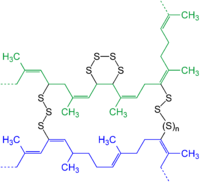
Photo from wikipedia
Cyclodextrin-based nanosponges (CD-NS) are a novel class of polymers cross-linked with a three-dimensional network and can be obtained from cyclodextrins (CD) and pyromellitic dianhydride. Their properties, such as their ability… Click to show full abstract
Cyclodextrin-based nanosponges (CD-NS) are a novel class of polymers cross-linked with a three-dimensional network and can be obtained from cyclodextrins (CD) and pyromellitic dianhydride. Their properties, such as their ability to form an inclusion complex with drugs, can be used in biomedical science, as nanosponges influence stability, toxicity, selectivity, and controlled release. Most pharmaceutical research use CD-NS for the delivery of drugs in cancer treatment. Application of molecular targeting techniques result in increased selectivity of CD-NS; for example, the addition of disulfide bridges to the polymer structure makes the nanosponge sensitive to the presence of glutathione, as it can reduce such disulfide bonds to thiol moieties. Other delivery applications include dermal transport of pain killers or photosensitizers and delivery of oxygen to heart cells. This gives rise to the opportunity to transition to medical scaffolds, but more, in modern times, to create an ultrasensitive biosensor, which employs the techniques of surface-modified nanoparticles and molecularly imprinted polymers (MIP). The following review focuses on the biomedical research of cyclodextrin polymers cross-linked via dianhydrides of carboxylic acids.
Journal Title: Applied Sciences
Year Published: 2020
Link to full text (if available)
Share on Social Media: Sign Up to like & get
recommendations!